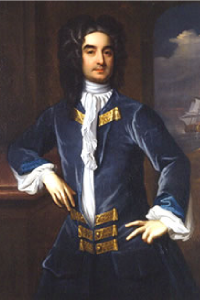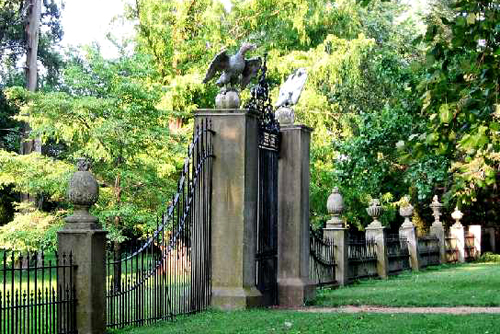
About Historic Westover
About
Westover is owned by the Fisher and Erda families and currently being lived in by the 4th and 5th generations of their family to call Westover home. The house, being a private residence, is open to the public only during Historic Garden Week and for Westover Church’s annual Autumn Pilgrimage in September or by private appointment. The grounds and garden, however, are open year-round. There are no state or federal programs to assist with the maintenance and upkeep of the house; Westover relies on visitors and special events to help her continue. As such, the family greatly appreciates your visit and hopes you will come back again soon.
History
Westover is a living link to our country’s past, whose story involves indigenous peoples, the indentured, the enslaved, early European settlers and generations of their descendants.
Several years after the landing of the colonists at Jamestown in 1607, a private English company undertook to settle lands further upstream along the James River. Such settlements then were known as "Hundreds," so called because of the desired number of persons to be settled. Included among the leaders of these settlers were John Rolfe, husband of Pocahontas, and Francis, John and Nathaniel West (brothers of Lord Delaware, the first colonial governor of Virginia).
Westover may have been first cleared by Native Americans for farmland prior to the colonists sailing up the James in the early 1600s. Certainly, Algonquin peoples, whose lands once stretched all the way from the southeastern coastal plain to near the Arctic Circle, lived on and around these lands for centuries before the English arrived, and many pre-historic archaeological sites have been identified across the property. Recent points (or arrowheads) found here have been dated by the Department of Historic Resources to be as old as 6500BC. Today, the Chickahominy Tribe calls Charles City home.
Westover was formally established by colonists in 1619 and most likely got its name from the West brothers, Francis, John and Nathaniel (brothers of Lord Delaware, the first colonial governor of Virginia). In 1637, the Governor patented 2,000 acres of Westover to a Captain Thomas Pawlett, who thus became the property’s first recorded owner.
William Byrd I purchased Westover in 1688; at that time, it encompassed about 1,000 acres. He owned over 35,000 acres, and his son William Byrd II continued to expand the family’s land-holdings, eventually owning 179,000 acres across Virginia and North Carolina. Today, Westover is about 1,000 acres.
William Byrd II was born in Virginia and sent to England around the age of 7 for his schooling. He was educated in the classics, business and the law. He socialized in high social circles and had many aristocratic friends. He returned to Westover at the age of 30 to take over upon the death of his father. Byrd II was known as the Black Swan of Westover. He was a wealthy planter, surveyor, government official and author. He is considered to have been the most educated man in the colonies during his lifetime. He is also among Virginia’s first historians: in 1728, he accompanied the joint expedition that surveyed the dividing line between Virginia and North Carolina. Byrd wrote two histories of that event: The History of the Dividing Line Betwixt Virginia and North Carolina, which was intended for public consumption; and the private, rather bawdy version of the story, his Secret History of the Line.
These Dividing Line histories have found many editors since the early nineteenth century, one of which wrote in an introduction to a 1958 edition that it "is one of the most urbane and readable literary productions of the colonial period. It is written with grace and ease and is seasoned with humor—one of the rarest qualities in colonial writing."
Both William Byrd I (in the cemetery) and WB II (in the center of the garden) are buried at Westover.
Westover remained in the Byrd family until the death of Mrs. Byrd III in 1814. Between her death and the purchase of Westover by the Crane family, there were seven different owners.
| Francis, John, Nathaniel West | 1634-1637 | Robert Douthat | 1821-1828 | |
| Thomas Pawlett | 1637-1643 | George Harrison | 1828-1829 | |
| Sir John Pawlett | 1643-1665 | John Selden | 1829-1862 | |
| Theodorick Bland | 1665-1688 | Clay Drewry/Andrew Ellett | 1862-1866 | |
| T. Bland Jr./Richard Bland | 1688 | Augustus Drewry | 1866-1899 | |
| William Byrd I | 1688-1701 | Claris Sears Ramsey | 1899-1921 | |
| William Byrd II | 1701-1744 | Richard Crane | 1921-1938 | |
| William Byrd III | 1744-1776 | Ellen Bruce Crane | 1938-1952 | |
| Mrs. William Byrd III | 1776-1814 | Bruce Crane Fisher | 1952-1999 | |
| William Carter | 1814-1821 |

During the American Civil War, Major General George B. McClellan was headquartered at nearby Berkeley Plantation; McClellan’s protégé, Gen. Fitz John Porter was stationed at Westover with his troops. Legend has it that Westover's East wing was hit by a cannon—intended for Union troops—shot by Confederate soldiers on the south side of the James. The wing caught fire and lay in ruin until Mrs. Clarise Sears Ramsey, a Byrd descendent, purchased the property in 1899. She was instrumental in modernizing the house, rebuilding the East wing and adding hyphens to connect the main house to the previously separate dependencies, thereby creating one long building. In 1921, Mr. and Mrs. Richard Crane acquired Westover. Today, Andrea (Richard Crane's great-grandaughter) and Rob Erda and their family make Westover home and care for this special historic landmark.
Indigenous and Enslaved at Westover
Westover is richer for the contributions and sacrifices of those who histories are intricately entwined at Westover but have not yet been fully told, particularly those of the indigenous peoples and the enslaved and indentured.
We do not know the number of enslaved who lived and toiled here during William Byrd II’s lifetime, but with a large house and hundreds of acres under cultivation, they probably numbered in the hundreds. William Byrd III (1744-1776) and John Selden (1829-1862) also owned slaves; the names of those we know are hung in the Old Kitchen building and can also be accessed through the Richard M. Bowman Center for Local History’s Enslaved Ancestor File.
Westover continues the critical process of researching the history of the enslaved here and updating its narrative to incorporate their lives and contributions. It was in large part due to their labor and artistry that places like Westover and colonial America were built and succeeded. A partnership with the Virginia Department of Historic Resources is facilitating archaeological field tests to uncover more, including locating prehistoric indigenous sites, enslaved quarters and burial grounds, and a 17th Century courthouse, brewpub, and original Westover Church. Read more.
Westover welcomes any documentation and accounts of oral history from descendants of Westover’s enslaved. History cannot be undone, but we hope that in its truthful telling, there are opportunities for reconciliation and healing for people of all backgrounds.
On this page:
About
History
Indigenous and Enslaved at Westover

William Byrd II

Evelyn Byrd
William Byrd II's tombstone epitaph begins on the north side of the monument:

Here lyeth the Honourable William Byrd Esq being born to one of the
amplest fortunes in this country he was sent early to England for his
education where under the care and instruction of Sir Robert Southwell
and ever favored with his particular instructions he made a happy proficiency
in polite and various learning; by the means of the same noble friend
he was introduced to the acquaintance of many of the first persons of
that age for knowledge, wit, virtue, birth, or high station, and particularly
attracted a most close and bosom friend-ship with the learned and illustrious
Charles Boyle Earl of Orrey. He was called to the bar in the Middle
Tem-ple, studied for some time in the low countries, visited the court
of France and was chosen Fellow of the Royal Society.
It continues on the south side:
Thus eminently fitted for the service and ornament of his Country, he was made Receiver general of his Majesty’s revenues here, was thrice appointed publick agent to the Court and ministry of England, and being thirty-seven years a member at last became President of the council of this Colony to all this were added a great elegancy of taste and life, the well-bred gentleman and polite companion the splendid Oeconomist and prudent father of a family with the constant enemy of all ex-horbitant power and hearty friend to the liberties of his Country, Nat: Mar. 28 1674 Mort. Aug. 26 1744 An. AEtat 70.
Westover grounds include formal gardens, a rare iron clairvoyee, outbuildings such as a five-hole privy, tunnel, and icehouse, several barns of varying ages, and three 18th-century English wrought-iron gates, the finest from the 18th-century in this county. Westover Church originally stood half a mile west of the house and the site still includes burial plots of a number of prominent Virginians, including the first Benjamin Harrison of Berkeley and his wife as well as William Byrd I and his wife and William Byrd II’s daughter, Evelyn Byrd.
 The pillars of the iron clairvoyee
on the north side of the house are capped with icons of virtue:
The pillars of the iron clairvoyee
on the north side of the house are capped with icons of virtue:
• Pineapple for Hospitality
• Greek Key for Wisdom
• Urn Of Flowers for Beauty
• Cornucopia for Horn of Plenty
• Bee Hive for Industry
• Acorn for Perseverance
